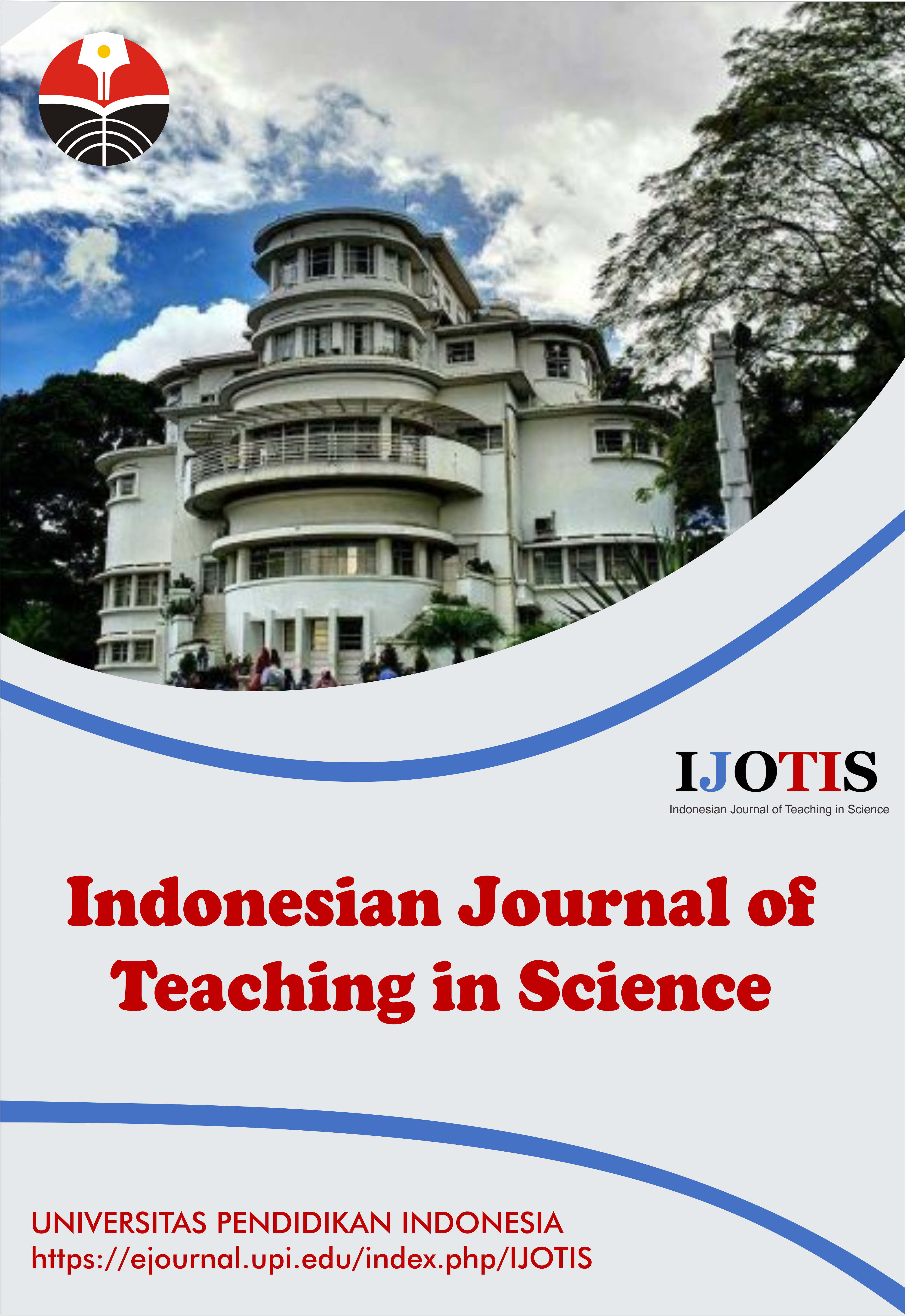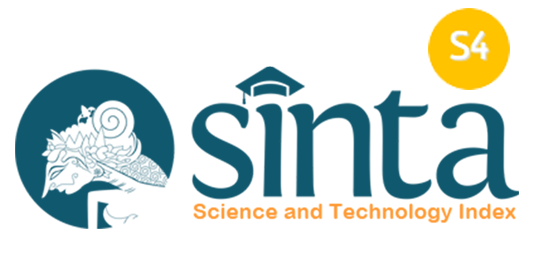Investigating Students’ Creativity through STEM-Engineering Design Process in Element, Compound, and Mixture Topic
Abstract
Keywords
Full Text:
PDFReferences
Aguilera, D., and Ortiz-Revilla, J. (2021). STEM vs. STEAM education and student creativity: A systematic literature review. Education Sciences, 11(7), 331.
Alemdar, M., Moore, R. A., Lingle, J. A., Rosen, J., Gale, J., and Usselman, M. C. (2018). The impact of a middle school engineering course on students' academic achievement and non-cognitive skills. International Journal of Education in Mathematics, Science and Technology, 6(4), 363-380.
Altan, E. B., and Tan, S. (2021). Concepts of creativity in design based learning in STEM education. International Journal of Technology and Design Education, 31(3), 503-529.
Anh, N. T. van, Bien, N. van, Son, D. van, and To Khuyen, N. T. (2022). STEM clubs: The promising space to foster students’ creativity. International Journal of STEM Education for Sustainability, 2(1), 45–52.
Avsec, S., and Savec, V. F. (2019). Creativity and critical thinking in engineering design: the role of interdisciplinary augmentation. Global Journal of Engineering Education, 21(1), 30-36.
Baydere, F. K., and Bodur, A. M. (2022). 9th grade students’ learning of designing an incubator through instruction based on engineering design tasks. Journal of Science Learning, 5(3), 500–508.
Berland, L., Steingut, R., and Ko, P. (2014). High school student perceptions of the utility of the engineering design process: Creating opportunities to engage in engineering practices and apply math and science content. Journal of Science Education and Technology, 23(6), 705-720.
Conradty, C., and Bogner, F. X. (2018). From STEM to STEAM: How to monitor creativity. Creativity Research Journal, 30(3), 233–240.
Cropley, D. H., and Cropley, A. J. (2000). Fostering creativity in engineering undergraduates. High Ability Studies, 11(2), 207–219.
Daly, S. R., Mosyjowski, E. A., and Seifert, C. M. (2014). Teaching creativity in engineering courses. Journal of Engineering Education, 103(3), 417–449.
Denson, C. D. (2015). Developing instrumentation for assessing creativity in engineering design. Journal of Technology Education, 27(1), 23–40.
English, L. D., and King, D. T. (2015). STEM learning through engineering design: Fourth-grade students’ investigations in aerospace. International Journal of STEM Education, 2, 1-18.
English, L. D., King, D., and Smeed, J. (2017). Advancing integrated STEM learning through engineering design: Sixth-grade students' design and construction of earthquake-resistant buildings. Journal of Educational Research, 110(3), 255-271.
Erduran, S. (2020). Nature of “STEM”? Epistemic underpinnings of integrated science, technology, engineering, and mathematics in education. Science and education, 29, 781-784.
Eroglu, S. and Bektas, O. (2022). The effect of STEM applications on the scientific creativity of 9th-grade students. Journal of Education in Science, Environment and Health (JESEH), 8(1), 17-36.
Felder, R. (1987). On creating creative engineers. Engineering Education, 77(4), 222–227.
Guzey, S. S., Moore, T. J., and Harwell, M. (2016). Building up STEM: An analysis of teacher-developed engineering design-based STEM integration curricular materials. Journal of Pre-College Engineering Education Research (J-PEER), 6(1), 11-29.
Hammack, R., Ivey, T. A., Utley, J., and High, K. A. (2015). Effect of an engineering camp on students’ perceptions of engineering and technology. Journal of Pre-College Engineering Education Research (J-PEER), 5(2), 10-21.
Han, H. J., and Shim, K. C. (2019). Development of an engineering design process-based teaching and learning model for scientifically gifted students at the science education institute for the gifted in South Korea. Asia-Pacific Science Education, 5(1), 1–18.
Hanif, S., Wijaya, A. F. C., and Winarno, N. (2019). Enhancing students' creativity through STEM project-based learning. Journal of science Learning, 2(2), 50-57.
Hathcock, S. J., Dickerson, D. L., Eckhoff, A., and Katsioloudis, P. (2015). Scaffolding for creative product possibilities in a design-based STEM activity. Research in Science Education, 45(5), 727–748.
Huang, N. T., Chang, Y. S., and Chou, C. H. (2020). Effects of creative thinking, psychomotor skills, and creative self-efficacy on engineering design creativity. Thinking Skills and Creativity, 37, 100695.
Jang, H. (2016). Identifying 21st century STEM competencies using workplace data. Journal of Science Education and Technology, 25, 284-301.
Jindal-Snape, D., Davies, D., Collier, C., Howe, A., Digby, R., and Hay, P. (2013). The impact of creative learning environments on learners: A systematic literature review. Improving Schools, 16(1), 21–31.
Kazerounian, K., and Foley, S. (2007). Barriers to creativity in engineering education: A study of instructors and students perceptions. Journal of Mechanical Design, 129, 761–768.
Klukken, P. G., Parsons, J. R., and Colubus, P. J. (1997). The creative experience in engineering practice: Implications for engineering education. Journal of Engineering Education, 86(2), 133–138.
Kozbelt, A., Beghetto, R. A., and Runco, M. A. (2010). Theories of creativity. The Cambridge Handbook of Creativity, 2, 20-47.
Meltzer, D. E. (2002). The relationship between mathematics preparation and conceptual learning gains in physics: A possible “hidden variable” in diagnostic pretest scores. American Journal of Physics, 70(12), 1259–1268.
Miller, A. L. (2014). A self-report measure of cognitive processes associated with creativity. Creativity Research Journal, 26(2), 203–218.
Miller, A. L., and Dumford, A. D. (2016). Creative cognitive processes in higher education. Journal of Creative Behavior, 50(4), 282–293.
Miller, S. R., Hunter, S. T., Starkey, E., Ramachandran, S., Ahmed, F., and Fuge, M. (2021). How should we measure creativity in engineering design? A comparison between social science and engineering approaches. Journal of Mechanical Design, 143(3), 031404.
Nordin, N. A. H. M. (2022). A bibliometric analysis of computational mapping on publishing teaching science engineering using VOSviewer application and correlation. Indonesian Journal of Teaching in Science, 2(2), 127-138.
Nurtanto, M., Pardjono, P., Widarto, W., and Ramdani, S. D. (2020). The effect of STEM-EDP in professional learning on automotive engineering competence in vocational high school. Journal for the Education of Gifted Young Scientists, 8(2), 633–649.
Park, D.-Y., Park, M.-H., and Bates, A. B. (2018). Exploring young children’s understanding about the concept of volume through engineering design in a STEM activity: A case study. International Journal of Science and Mathematics Education, 16(2), 275-294.
Rockyane, I. S., and Sukartiningsih, W. (2018). Pengembangan media pembelajaran interaktif menggunakan adobe flash dalam pembelajaran menulis cerita siswa kelas IV SD. Jurnal Mahasiswa Universitas Negeri Surabaya, 6(5), 767-776.
Shahali, E. H. M., Halim, L., Rasul, M. S., Osman, K., and Zulkifeli, M. A. (2017). STEM learning through engineering design: Impact on middle secondary students’ interest towards STEM. Eurasia Journal of Mathematics, Science and Technology Education, 13(5), 1189–1211.
Siew, N. M. (2017). Fostering students’scientific imagination in STEM through an engineering design process. Problems of Education in the 21st Century, 75(4), 375-393.
Siew, N. M., Goh, H., and Sulaiman, F. (2016). Integrating STEM in an engineering design process: The learning experience of rural secondary school students in an outreach challenge program. Journal of Baltic Science Education, 15(4), 477.
Starkey, E., Toh, C. A., and Miller, S. R. (2016). Abandoning creativity: The evolution of creative ideas in engineering design course projects. Design Studies, 47, 47-72.
Sulistiyowati, S., Abdurrahman, A., and Jalmo, T. (2018). The effect of STEM-based worksheet on students’ science literacy. Tadris: Jurnal Keguruan Dan Ilmu Tarbiyah, 3(1), 89.
Tan, T., Zou, H., Chen, C., and Luo, J. (2015). Mind wandering and the incubation effect in insight problem solving. Creativity Research Journal, 27(4), 375–382.
Tolbert, D., and Daly, S. R. (2013). First-year engineering student perceptions of creative opportunities in design. International Journal of Engineering Education, 29(4), 879–890.
Veety, E. N., Sur, J. S., Elliott, H. K., and Lamberth, J. E. (2018). Teaching engineering design through wearable device design competition (evaluation). Journal of Pre-College Engineering Education Research, 8(2), 1–9.
Winarni, E. W., Karpudewan, M., Karyadi, B., and Gumono, G. (2022). Integrated PjBL-STEM in scientific literacy and environment attitude for elementary school. Asian Journal of Education and Training, 8(2), 43–50.
Winarno, N., Rusdiana, D., Samsudin, A., Susilowati, E., Ahmad, N. J., and Afifah, R. M. A. (2020). Synthesizing results from empirical research on engineering design process in science education: A systematic literature review. Eurasia Journal of Mathematics, Science and Technology Education, 16(12), 1–18.
Zheng, X., Ritter, S. C., and Miller, S. R. (2018). How concept selection tools impact the development of creative ideas in engineering design education. Journal of Mechanical Design, Transactions of the ASME, 140(5).
Zhou, N., Pereira, N. L., George, T. T., Alperovich, J., Booth, J., Chandrasegaran, S., Tew, J. D., Kulkarni, D. M., and Ramani, K. (2017). The influence of toy design activities on middle school students’ understanding of the engineering design processes. Journal of Science Education and Technology, 26(5), 481–493.
DOI: https://doi.org/10.17509/ijotis.v4i1.68081
Refbacks
- There are currently no refbacks.
Copyright (c) 2024 Universitas Pendidikan Indonesia

This work is licensed under a Creative Commons Attribution-ShareAlike 4.0 International License.
 Indonesian Journal of Teaching in Science
Indonesian Journal of Teaching in Science



